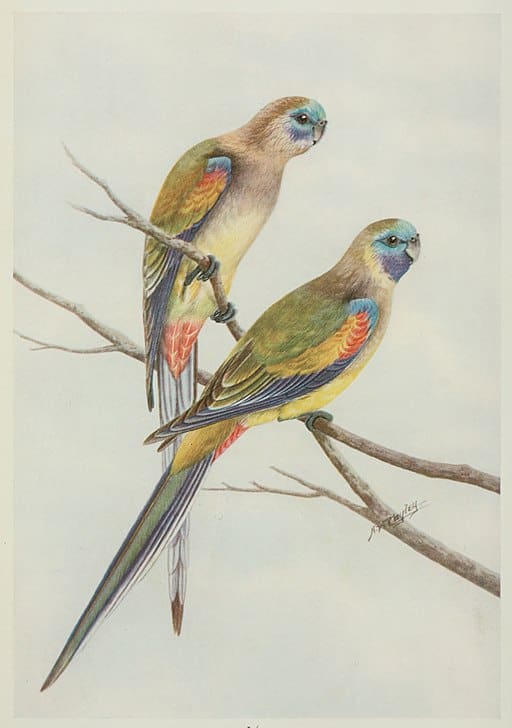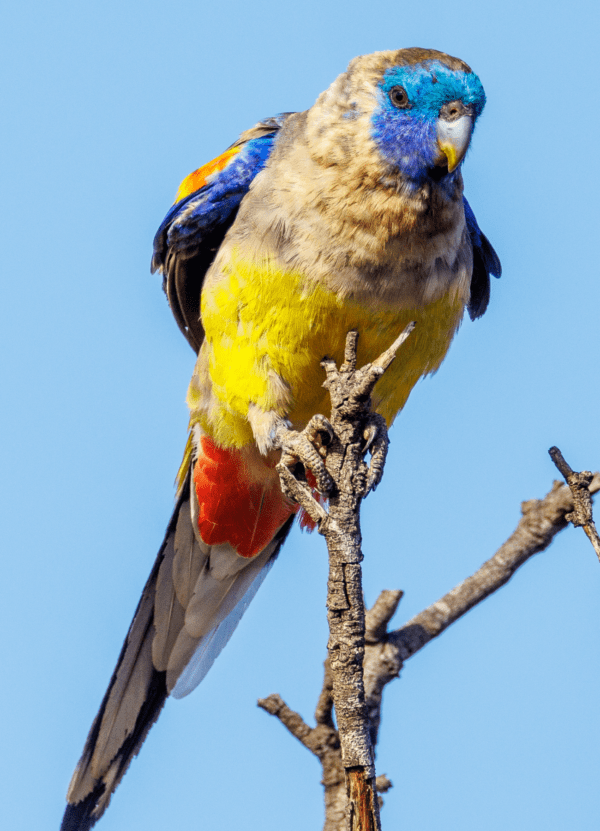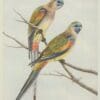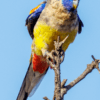Naretha Bluebonnet
Also known as:
Little Bluebonnet
Also known as:
Little Bluebonnet
DID YOU KNOW?
The Naretha Bluebonnet is considered a full species by some authors and by others as conspecific with the Bluebonnet (Northiella haematogaster).

Northiella

narethae
Size:
About 28 cm (11 in).
Weight:
About 90 g (3.2 oz).
Subspecies including nominate:
one
Colour Adult:
Both adults green/blue forecrown, lores and area above eyes; dark lilac/blue on chin and forecheeks; deep yellow on abdomen and thighs, paler in female; red undertail coverts; orange/red outer lesser wing coverts, duller red in female; smaller in size. Legs and feet are dark grey and the iris is dark brown.
Colour Juvenile:
As in adult female but duller; in young females varying orange/red markings on thighs.
Call:
A harsh, abrupt cluck cluck; when alarmed is repeated more rapidly. When at rest gives piping whistles.
More Information:
Content Sources:
Wikpedia
Cornell Lab of Ornithology/Birds of the World
Parrots: A Guide to Parrots of the World, Juniper and Parr, 1998.
Parrots of the World, third ed., Forshaw and Cooper, 1989.
Captive Status:
—
Longevity:
15 years.
Housing:
Walk-in enclosure, minimum length 3 m (9.8 ft).
Diet:
Small seed mix such as: canary, millet and smaller amounts of oats, buckwheat, safflower and a little hemp; limited sunflower seed; spray millet; green leaves such as: Swiss chard, lettuce, sowthistle, dandelion, chickweed; seeding grasses; rearing food made from: hardboiled egg and carrot, all ground to crumbly consistency; fruit such as: apple, pear, banana, orange, pomegranate, kiwi, cactus fruits; complete pellet.
Enrichment:
Enjoys bathing, as well as scratching around in sand or soil. Also provide bird-safe, unsprayed flowering branches for chewing, as well as fir, pine or willow branches.
Nest Box Size:
Vertical box 6″ x 6″ x 16″ (15 cm x 15 cm x 40.6 cm)
Clutch Size:
5-6
Fledging Age:
5 weeks
Hatch Weight:
—
Peak Weight:
—
Weaning Weight:
—
World Population:
Unknown, declining.
IUCN Red List Status:
Not listed
CITES Listing:
Appendix II
As conspecific with N. haematogaster.
Threat Summary:
Has suffered from trapping; its population may be fewer than 5000 individuals.
Range:
Restricted to SE Western Australia, west to SW South Australia.
Habitat:
Is found in dry areas with desert sheoak and mulga. They are often observed more in areas where water troughs for stock are found.
Wild Diet:
Has been recorded taking seeds of various Acacia, also Heterodendron oleifolium, Danthonia caespitosa, Helipterum, Sonchus oleraceus and the mistletoes Amyema quandong and Lyiana exocarpi, and Lepidoptera larvae; reported to prefer seeds of Helipterum when feeding young.
Ecology and Behaviour:
Moves seasonally with the rains, while congener N. haematogaster is resident. Are usually seen in pairs or small groups of up to 20 birds. Boisterous and active, this species assembles early to drink and then goes off to feed. The birds feed both on the ground and in trees.
Clutch and Egg Size:
5-6 rounded eggs, 23.5 x 19.5 mm (0.9 x 0.7 in)
Breeding Season:
July-December; nest is in tree cavity.





